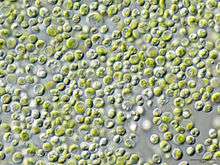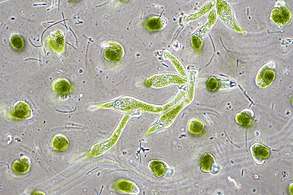Chlorella vulgaris
Chlorella vulgaris is a green microalgae mainly used as a dietary supplement or protein-rich food additive in Japan.
| Chlorella vulgaris | |
|---|---|
 | |
| Chlorella vulgaris on microscope view | |
| Scientific classification | |
| Phylum: | Chlorophyta |
| Class: | Trebouxiophyceae |
| Order: | Chlorellales |
| Family: | Chlorellaceae |
| Genus: | Chlorella |
| Species: | C. vulgaris |
| Binomial name | |
| Chlorella vulgaris Beijerinck 1890 | |
| Varieties | |
| |
| Synonyms[1] | |
| |

Introduction
C. vulgaris is a green eukaryotic microalgae in the genus Chlorella, which has been present on earth since the Precambrian period.[3] This unicellular algae was discovered in 1890 by Martinus Willem Beijerinck as the first microalgae with a well-defined nucleus.[4] At the beginning of the 1990s, German scientists noticed the high protein content of C. vulgaris and began to consider it as a new food source. Japan is currently the largest consumer of Chlorella.[3][5]
Production
The world annual production of the various species of Chlorella was 2000 tonnes (dry weight) in 2009, with the main producers being Germany, Japan and Taiwan.[3] C. vulgaris constitutes an excellent candidate for production due to its high resistance against rough conditions and invading organisms. In addition, the production of the various organic macromolecules of interest (proteins, lipids, starch) differ depending on the technique used to create biomass and can be therefore targeted.[3] Under more hostile conditions, the biomass decreases but lipids and starch contents increase.[6] Under favourable conditions, protein content raises along with the biomass.[7] Different growth techniques have been developed. They exploit the autotrophic, heterotrophic or mixotrophic properties of C. vulgaris. Growing C. vulgaris autotrophically is illustrated by the closed photo-bioreactor. Harvesting the biomass is then generally done by centrifugation due to the high process efficiency (95% recovery). Other techniques exist, such as flocculation, filtration[8] and flotation.[9]
Uses
Bioenergy
C. vulgaris is seen as a promising source of bioenergy. It may be a good alternative to biofuel crops, like soybean, corn or rapeseed, as it is more productive and does not compete with food production.[10] It can produce large amount of lipids, up to 20 times more than crops[11] that have a suitable profile for biodiesel production.[12] This microalgae also contains high amounts of starch, good for the production of bioethanol.[3] However, microalgal biofuels are far from competitive with fossil fuels, given their high production costs and controversial sustainability.[3][13]
Food
The proteins content of C. vulgaris varies from 42 to 58% of its biomass dry weight.[14][15][16][17] These proteins are considered as having a good nutritional quality compared to the standard profile for human nutrition of the World Health Organization and Food and Agriculture Organization, as the algae synthesizes amino acids.[3] The algae also contains lipids (5–40% of the dry mass),[14] carbohydrates (12–55% dry weight)[18][19] and pigments with among others chlorophyll, reaching 1–2 % of the dry weight.[20][21]
C. vulgaris contains minerals and vitamins.[3] C. vulgaris is marketed as dietary supplement, additive,[22][23] as colourant or food emulsion.[24] They are all in the form of capsules, extracts, tablets or powder.[25][26] They are consumed in Japan as a medical treatment.[5][27] However, despite its high protein content, C. vulgaris is not yet widely incorporated in food products. The main reason for this is its dark green colour and its smell, which is close to that of fish.[28] Vitamin B12, specifically in the form of methylcobalamin, has been identified in Chlorella vulgaris.[29]
References
- "Chlorella vulgaris". NCBI taxonomy. Bethesda, MD: National Center for Biotechnology Information. Retrieved 5 December 2017.
Other names: synonym: Chlorella vulgaris var. viridis Chodat includes: Chlorella vulgaris Beijerink IAM C-27 formerly Chlorella ellipsoidea Gerneck IAM C-27
- Duval B., Margulis L. (1995). "The microbial community of Ophrydium versatile colonies: endosymbionts, residents, and tenants". Symbiosis. 18: 181–210. PMID 11539474.
- Safi, C., Zebib, B., Merah, O., Pontalier, P. Y., & Vaca-Garcia, C. (2014). "Morphology, composition, production, processing and applications of Chlorella vulgaris: A review" (PDF). Renewable and Sustainable Energy Reviews. 35: 265–278. doi:10.1016/j.rser.2014.04.007.CS1 maint: multiple names: authors list (link)
- Beijerinck, M. W. (1890). "Culturversuche mit Zoochlorellen, Lichenengonidien und anderen niederen Algen". Bot. Zeitung. 48: 781–785.
- Kitada, K., Machmudah, S., Sasaki, M., Goto, M., Nakashima, Y., Kumamoto, S., & Hasegawa, T. (2009). "Supercritical CO2 extraction of pigment components with pharmaceutical importance from Chlorella vulgaris". Journal of Chemical Technology and Biotechnology. 84 (5): 657–661. doi:10.1002/jctb.2096.CS1 maint: multiple names: authors list (link)
- Přibyl, P., Cepak, V., & Zachleder, V. (2012). "Production of lipids in 10 strains of Chlorella and Parachlorella, and enhanced lipid productivity in Chlorella vulgaris". Applied Microbiology and Biotechnology. 94 (2): 549–61. doi:10.1007/s00253-012-3915-5. PMID 22361856.CS1 maint: multiple names: authors list (link)
- Chisti, Y. (2007). "Biodiesel from microalgae". Biotechnology Advances. 25 (3): 294–306. doi:10.1016/j.biotechadv.2007.02.001. PMID 17350212.
- Lee, D. J., Liao, G. Y., Chang, Y. R., & Chang, J. S. (2012). "Coagulation-membrane filtration of Chlorella vulgaris". Bioresource Technology. 108: 184–189. doi:10.1016/j.biortech.2011.12.098. PMID 22261659.CS1 maint: multiple names: authors list (link)
- Cheng, Ya-Ling; Juang, Yu-Chuan; Liao, Guan-Yu; Ho, Shih-Hsin; Yeh, Kuei-Ling; Chen, Chun-Yen; Chang, Jo-Shu; Liu, Jhy-Chern; Lee, Duu-Jong (2010). "Dispersed ozone flotation of Chlorella vulgaris". Bioresource Technology. 101 (23): 9092–9096. doi:10.1016/j.biortech.2010.07.016. PMID 20675123.
- Singh, A., Nigam, P. S., & Murphy, J. D. (2011). "Renewable fuels from algae: An answer to debatable land based fuels". Bioresource Technology. 102 (1): 10–16. doi:10.1016/j.biortech.2010.06.032. PMID 20615690.CS1 maint: multiple names: authors list (link)
- Demirbas, M. F. (2011). "Biofuels from algae for sustainable development". Applied Energy. 88 (10): 3473–3480. doi:10.1016/j.apenergy.2011.01.059.
- Wang, K. G., Brown, R. C., Homsy, S., Martinez, L., & Sidhu, S. S. (2013). "Fast pyrolysis of microalgae remnants in a fluidized bed reactor for bio-oil and biochar production". Bioresource Technology. 127: 494–499. doi:10.1016/j.biortech.2012.08.016. PMID 23069615.CS1 maint: multiple names: authors list (link)
- Lavars, Nick (2019-09-19). "Algae-fueled bioreactor soaks up CO2 400x more effectively than trees". New Atlas. Retrieved 2019-10-04.
- Becker, E. W. (1994). Microalgae: biotechnology and microbiology. Vol. 10. Cambridge University Press.
- Morris, H. J., Almarales, A., Carrillo, O., & Bermúdez, R. C. (2008). "Utilisation of Chlorella vulgaris cell biomass for the production of enzymatic protein hydrolysates". Bioresource Technology. 99 (16): 7723–7729. doi:10.1016/j.biortech.2008.01.080. PMID 18359627.CS1 maint: multiple names: authors list (link)
- Servaites, J. C., Faeth, J. L., & Sidhu, S. S. (2012). "A dye binding method for measurement of total protein in microalgae". Analytical Biochemistry. 421 (1): 75–80. doi:10.1016/j.ab.2011.10.047. PMID 22138185.CS1 maint: multiple names: authors list (link)
- Seyfabadi, J., Ramezanpour, Z., & Khoeyi, Z. A. (2011). "Protein, fatty acid, and pigment content of Chlorella vulgaris under different light regimes". Journal of Applied Phycology. 23 (4): 721–726. doi:10.1007/s10811-010-9569-8.CS1 maint: multiple names: authors list (link)
- Brányiková, I., Maršálková, B., Doucha, J., Brányik, T., Bišová, K., Zachleder, V., & Vítová, M. (2011). "Microalgae—novel highly efficient starch producers". Biotechnology and Bioengineering. 108 (4): 766–776. doi:10.1002/bit.23016. PMID 21404251.CS1 maint: multiple names: authors list (link)
- Choix, F. J., de-Bashan, L. E., & Bashan, Y. (2012). "Enhanced accumulation of starch and total carbohydrates in alginate-immobilized Chlorella spp. induced by Azospirillum brasilense: II. Heterotrophic conditions". Enzyme and Microbial Technology. 51 (5): 300–309. doi:10.1016/j.enzmictec.2012.07.013. PMID 22975128.CS1 maint: multiple names: authors list (link)
- de-Bashan, L. E., Bashan, Y., Moreno, M., Lebsky, V. K., & Bustillos, J. J. (2002). "Increased pigment and lipid content, lipid variety, and cell and population size of the microalgae Chlorella spp. when co-immobilized in alginate beads with the microalgae-growth-promoting bacterium Azospirillum brasilense". Canadian Journal of Microbiology. 48 (6): 514–521. doi:10.1139/w02-051. PMID 12166678.CS1 maint: multiple names: authors list (link)
- Gonzalez, L. E., & Bashan, Y. (2000). "Increased growth of the microalga Chlorella vulgaris when coimmobilized and cocultured in alginate beads with the plant-growth-promoting bacterium Azospirillum brasilense". Applied and Environmental Microbiology. 66 (4): 1527–1531. doi:10.1128/aem.66.4.1527-1531.2000. PMC 92018. PMID 10742237.CS1 maint: multiple names: authors list (link)
- Fradique, M., Batista, A. P., Nunes, M. C., Gouveia, L., Bandarra, N. M., & Raymundo, A. (2010). "Incorporation of Chlorella vulgaris and Spirulina maxima biomass in pasta products. Part 1: Preparation and evaluation". Journal of the Science of Food and Agriculture. 90 (10): 1656–1664. doi:10.1002/jsfa.3999. PMID 20564448.CS1 maint: multiple names: authors list (link)
- Li, H.-B., Jiang, Y., & Chen, F. (2002). "Isolation and purification of lutein from the microalga Chlorella vulgaris by extraction after saponification". Journal of Agricultural and Food Chemistry. 50 (5): 1070–1072. doi:10.1021/jf010220b. PMID 11853482.CS1 maint: multiple names: authors list (link)
- Fernandes, B., Dragone, G., Abreu, A. P., Geada, P., Teixeira, J., & Vicente, A. (2012). "Starch determination in Chlorella vulgaris—a comparison between acid and enzymatic methods". Journal of Applied Phycology. 24 (5): 1203–1208. CiteSeerX 10.1.1.1024.1758. doi:10.1007/s10811-011-9761-5.CS1 maint: multiple names: authors list (link)
- Liang, S., Liu, X., Chen, F., & Chen, Z. (2004). Current microalgal health food R & D activities in China. Asian Pacific Phycology in the 21st Century: Prospects and Challenges. pp. 45–48. doi:10.1007/978-94-007-0944-7. ISBN 978-94-007-0944-7.CS1 maint: multiple names: authors list (link)
- Yamaguchi, K. (1996). "Recent advances in microalgal bioscience in Japan, with special reference to utilization of biomass and metabolites: a review". Journal of Applied Phycology. 8 (6): 487–502. doi:10.1007/BF02186327.
- Morris, H. J., Carrillo, O. V., Almarales, Á., Bermúdez, R. C., Alonso, M. E., Borges, L., Quintana, M. M., Fontaine, R., Llauradó, G., & Hernández, M. (2009). "Protein hydrolysates from the alga Chlorella vulgaris 87/1 with potentialities in immunonutrition". Biotecnología Aplicada. 26 (2): 162–165.CS1 maint: multiple names: authors list (link)
- Becker, E. (2007). "Micro-algae as a source of protein". Biotechnology Advances. 25 (2): 207–210. doi:10.1016/j.biotechadv.2006.11.002. PMID 17196357.
- Kumudha A, Selvakumar S, Dilshad P, Vaidyanathan G, Thakur MS, Sarada R. (2015). "Methylcobalamin--a form of vitamin B12 identified and characterised in Chlorella vulgaris". Journal of Food Chemistry. 170: 316–320. doi:10.1016/j.foodchem.2014.08.035. PMID 25306351.CS1 maint: multiple names: authors list (link)